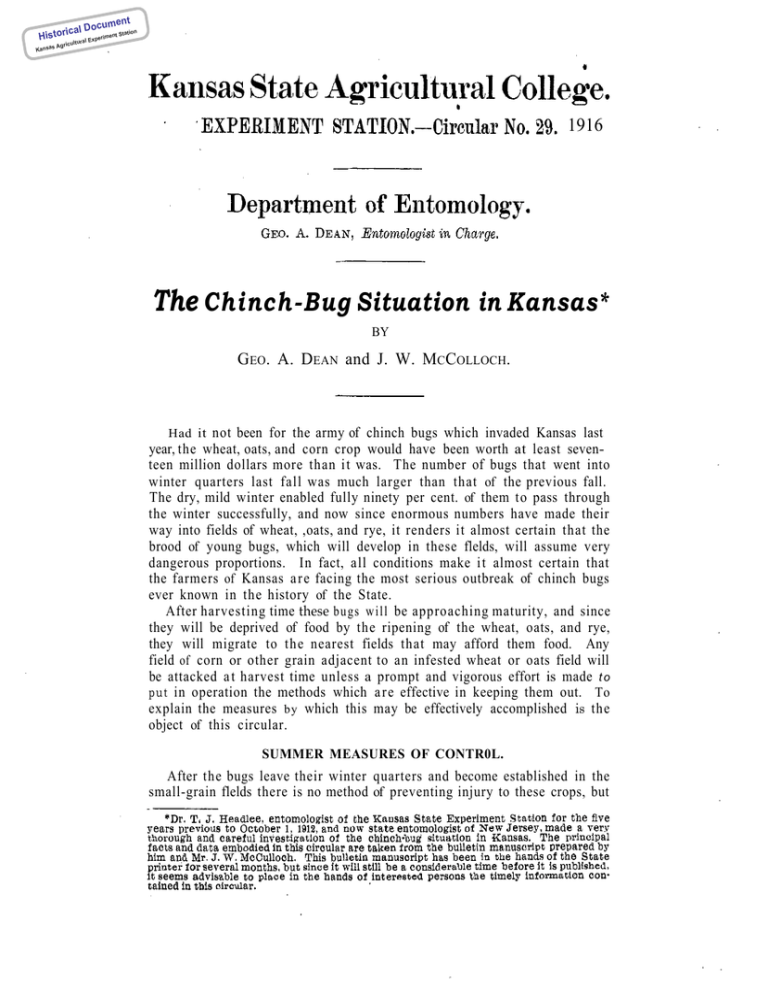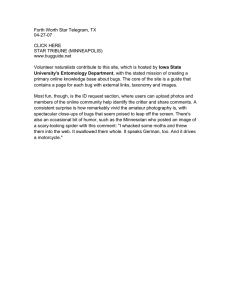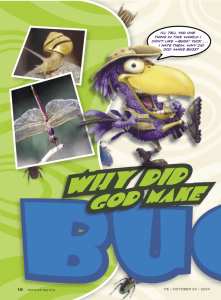The Chinch-Bug Situation in Kansas* 1916 G
advertisement

t cumen n io cal Do Histori tural Experiment Stat ricul Ag Kansas 1916 The Chinch-Bug Situation in Kansas* BY GEO. A. DEAN and J. W. MCCOLLOCH. Had it not been for the army of chinch bugs which invaded Kansas last year, the wheat, oats, and corn crop would have been worth at least seventeen million dollars more than i t was. The number of bugs that went into winter quarters last fall was much larger than that of the previous fall. The dry, mild winter enabled fully ninety per cent. of them to pass through the winter successfully, and now since enormous numbers have made their way into fields of wheat, ,oats, and rye, it renders it almost certain that the brood of young bugs, which will develop in these flelds, will assume very dangerous proportions. In fact, all conditions make i t almost certain that the farmers of Kansas a r e facing the most serious outbreak of chinch bugs ever known in the history of the State. After harvesting time these bugs will be approaching maturity, and since they will be deprived of food by the ripening of the wheat, oats, and rye, they will migrate to the nearest fields that may afford them food. Any field of corn or other grain adjacent to an infested wheat or oats field will be attacked a t harvest time unless a prompt and vigorous effort is made t o p u t in operation the methods which a r e effective in keeping them out. To explain the measures by which this may be effectively accomplished is the object of this circular. SUMMER MEASURES OF CONTR0L. After the bugs leave their winter quarters and become established in the small-grain flelds there is no method of preventing injury to these crops, but t cumen n io cal Do Histori tural Experiment Stat Kansas Agricul by diligent work the corn, kafir, and sorghum crops may be saved from any injury. . The problem of summer destruction involves not only t h e necessity of getting the bugs to pass from the small grains while yet immature, but the necessity of maintaining efficient dust barriers during dry weather or road-oil barriers during wet weather, and the destruction of all bugs that succeed in crossing t h e barrier and congregate on the first few rows of corn. Ordinarily the small-grain fields ripen before the bugs are yet mature and they a r e thus forced to migrate on foot to other fields, Some years, however, the wheat i s so delayed in ripening that the bugs are mostly mature before harvest, and in such cases they migrate on the wing and nothing can be done to destroy them. At times, the wheat is so thin on the ground that a growth of grass and weeds furnishes the chinch bugs with food after the wheat ripens, thus allowing them to mature in the wheat fields before moving to corn. I n such cases harvest should be hastened and the field should be thoroughly disked to destroy all food for the bugs, and thus hasten the migration. THE DUST BARRIER. There a r e two types of dust barriers; namely, the double furrow and the single furrow. The first is made by plowing a strip about ten feet wide between the infested and non-infested fields and then reducing the soil to a fine duet by harrowing and dragging with a brush drag. Two troughs about four feet long a r e made of heavy lumber and held about a foot apart by a couple of 2x4-inch pieces nailed firmly across the top. This double trough, heavily weighted down, is dragged hack and forth on the plowed strip until two deep, parallel furrows are formed, the sides and bottoms of w h i c h are covered with a deep, fine dust. The siagle-furrow barrier is made by plowing a deep lister furrow between the infested fields and the non-infested fields. The sides and bottoms of this furrow are reduced to a deep, fine dust by dragging back and forth a heavy log wrapped with a log chain. The double-furrow barrier requires a little more time to construct, but demands less attention while the bugs are moving. Either type of barrier can be renewed readily by redragging. After the bugs a r e caught in these furrows they may be destroyed by either burning with a gasoline torch, crushing with the drags, o r by trapping in post holes. The most successful of these methods is to destroy them with a gasoline torch. This is done by flaming the sides and bottoms of the furrows at regular intervals with a strong gasoline torch. Although many bugs may be destroyed by continuous dragging while they are moving, this method has not been found successful, as many bugs a r e forced out of the furrow. The post-hole method has been found the least satisfactory of all. Holes a r e dug at intervals of ten feet in the bottoms of the furrows, and the bugs that a r e caught in these holes are destroyed by pouring kerosene over them. These holes have to be rebored after each dragging of the furrow, and the kerosene makes it hard to work up a dust. The gasoline-blast-torch method has proved itself to be admirably adapted to our needs, for not only a r e we able to destroy the bugs by simply passing the flame along the furrow, but the furrows can be repaired as t cumen n io cal Do Histori tural Experiment Stat Kansas Agricul often a s necessary by dragging the log or trough through them, The most efficient torch that we have used is known as the “Locust Torch,” and is manufactured by the Turner Brass Works of Sycamore, III. ROAD-OIL BARRIER. The efficiency of the road-oil barrier was first demonstrated by Prof. S. A. Forbes, of Illinois. I n giving his results he says: ‘‘The most satisfactory results, considering both cost and protection, have, been obtained from the line made of No. 7 road oil. This material, when properly applied, caught all the crawling bugs and was easy to maintain. It has been fully demonstrated that, by means of the road-oil line, with traps, and the soap spray, chinch bugs from whatever source can be rendered harmless.” I n his summary Professor Forbes says: “Its (the chinch bug’s) escape from infested fields t o other crops can best be prevented by surrounding. each field with a line of thick, viscid road oil (No. 7 of the Standard Oil Company), with post holes beside it some thirty feet apart. Such a line can be made and kept effective long enough to catch virtually all the bugs in a field at a minimum, expense of thirty-five cents a mile per day.” Road oil No. 7 is manufactured and sold by the Standard Oil Company at $3.50 a barrel, and can he obtained from the Standard Oil Refinery a t Whiting, Ind. Professor Forbes found it very advantageous for commercial clubs, local dealers, o r distributing agents to handle the oil in carload lots, thus saving much on freight rates and a t the same time making sure of having a supply when it is needed. The road-oil barrier is constructed by plowing a sharp backfurrow between the infested fields and the non-infested ones. Two two-inch planks, about eight feet long and twelve and fourteen inches wide, are nailed together, hog-trough fashion. The front end of the trough is rounded off like a sled runner, and in order that it may slip well the inside of the trough should be lined with galvanized iron. A smooth pole, about two and onehalf inches in diameter, is nailed into the bottom in, such a manner that it extends from the front end to a point eight inches behind t h e rear of the trough. A narrow, rectangular platform, running, the length of the trough and extending ten inches beyond the rear end, is then constructed on the ridge of the now inverted trough. This platform is intended for carrying the driver and any additional weight that is needed. By means of a strong wire o r chain, as attachment is made to the clevis and the inverted trough is ready for work. This trough is dragged up and down the backfurrow until a compact ridge is formed with a groove along the top of it. The oil is poured along this groove from a sprinkling can, the nozzle of which h a s been removed, in a stream, of sufficient size to make a line one-half to three-fourths of an inch in width. The bugs a r e destroyed by flaming along the oil line with the gasoline torch, the same as in the dust barrier. They may also be destroyed by digging post holes at the bottom of the slope on the bug-infested side. Where it is not possible to obtain road oil, coal tar can be substituted. The high price and scarcity of tar, and the fact that it h a s to be renewed more frequently, makes it rather objectionable for barriers. t cumen cal Do Histori Kansas riment Expe ultural Station Agric OPERATION OF BARRIERS. The farmer should keep in touch with what the bugs a r e doing in the small-grain fields, especially about harvest time, and should have his barrier materials ready for use when the time comes. A small strip between the infested and non-infested fields should be kept free from weeds so that when the barriers a r e constructed the ground will break u p nicely and be easily pulverized. It is necessary for the farmer to plan to use both types of barriers. At the first signs of migration the dust barrier should be constructed, if the weather is dry, and the ridge for the road-oil barrier should be prepared. The road-oil barrier should be placed between the dust barrier and the field to be protected, but the oil should not be placed on the barrier until, owing to wet weather, it is impossible to hold the bugs in the dust barrier. Harvest should start as early as possible so that the bugs will have to pass without delay. During the migration of the bugs there must be one person for each one-half to three-fourths of a mile of barrier in the field constantly burning or otherwise destroying the bugs that are caught in the barriers. Ordinarily the migration of chinch bugs from wheat to corn fields covers a period of from one to two weeks, depending on the amount of food left in the wheat field after harvest. We have found in our barrier work that for the most part the bugs move during the afternoon. Generally they begin passing about 4:00 p.m. reach the maximum between 5:00 and 5:30 p. m., and cease entirely about 7:00 p. m. During the entire period of migration in 1912 it was necessary to attend the barriers on a n average of about four hours. per day. On one or two cool days the bugs began migrating about 9:00 a. m. but the real migration did not begin until afternoon. RESULTS OF BARRIER WORK IN 1912. Last year the dust barrier and gasoline torch were given a thorough trial on the Experiment Station farm. A furrow two miles long was plowed between all wheat and corn fields. This furrow was six to eight inches deep and was dragged with a heavy log wrapped with a log chain until the sides and bottom. of it were reduced to a fine dust. This barrier was in constant use for fifteen days. Harvest began June 25, and from then on until July 8 the ground was black every afternoon with moving bugs. With the beginning of the heavy migration of bugs t h e management of the barriers was more or less systematized. The barriers were thoroughly dragged every day before 2:00 o'clock and then gone over with a hoe and all clods, sticks, and rubbish removed from the furrow. Two men were employed to operate the two torches, which were used continuously every day from 3:00 to 7:30 p. m. On two or three cool and partially cloudy days it was necessary to flame the furrows several times in the morning, and on a couple of days, when the migration was heaviest, it was necessary to use three torches for a n hour or two. Ordinarily one man with a torch can protect one-half to one mile of barrier. At no time during this migration did more than one bug in a thousand get across the barrier, and most of the time the per cent. was lower than t cumen n io cal Do Histori tural Experiment Stat Kansas Agricul this. Not a single row of corn was injured by the bugs, while in nearby fields where no barriers were used as high as two hundred rows of corn were entirely destroyed. The cost of constructing and maintaining the two miles of dust barrier is itemized as follows: Owing to rain on July 1 and 5, the road-oil barriers were used for about three days. Post holes and torches were used in destroying the bugs, but the post holes did not prove effective except where a ridge of dust was worked up around the holes, causing the bugs to roll in and also preventing them from crawling out again. The use of the gasoline torch proved very successful, except that i t served to dry out the oil. As a whole, the oil barrier did not prove as efficient as the dust barrier. As high as ten bugs out of every thousand were able to get across. It required constant watching to keep grass and rubbish from blowing onto it and forming a bridge for the bugs t o cross. It is to be recommended, however, when wet weather prevails. The cost of maintaining the oil barrier, was as follows: DESTROYING BUGS THAT CROSS THE BARRIERS. I t is impossible to keep all the bugs from getting over the barriers, and these bugs begin work on the first rows of corn. I n our work during the last two years we have found it possible and practical to destroy these bugs by spraying with, a soap spray or by flaming the corn with the gasoline torch. The soap spray is made by dissolving eight pounds of laundry soap in fifty gallons of water, and may be applied with any form of sprayer. In our work we have found the small knapsack sprayer very satisfactory for spraying corn. Since this spray kills the bugs only when it comes in actual contact with them, it must be applied in such a manner as to thoroughly wet the bugs. To do this it is necessary to fill the pockets formed by the leaves and the stem by drenching the plant, but care should be taken to keep the liquid out of the growing curl. The bugs must be destroyed shortly after they cross the barrier or they will soon distribute themselves over the field. Where it is impossible to spray, the flaming of the infested rows with the gasoline torch is to be recommended. Careful tests have shown that practically all the bugs on the corn plants can be destroyed by flaming the plants, but the corn is seriously injured by this treatment. t cumen n io cal Do Histori tural Experiment Stat Kansas Agricul THE ARTIFICIAL DISTRIBUTION OF THE CHINCH-BUG FUNGUS. During the past five years the Department of Entomology of Kansas State Experiment Station made a careful study of the fungous disease (Sporotrichum globuliferum) which attacks the chinch bugs, and in every part of the State where the bugs have been i n sufficient numbers to do injury the fungous disease was present. In other words, the disease has been found commonly distributed over the entire bug-infested districts of the State, attacking not only the chinch bug, but a large number of other species of insects. However, it should be stated that although the fungous disease seems everywhere to be present, the proper climatic conditions must be had in order for it to propagate; namely, plenty of moisture and summer temperatures. If these favorable conditions are had, the fungus will break out; and if the bugs are abundant, it will soon disseminate among them and sweep them off in great numbers. I n 1910 the University of Kansas made a careful investigation of the value of artificial distribution of the chinch-bug disease. The following statements are quoted from the conclusions derived from this investigation:* “The chinch-bug fungus is present naturally in fields everywhere throughout the infested area in Kansas. “It is present in such great abundance that any artificial distribution of infection in the field would be too insignificant, by comparison, to be of practical use. “Its distribution naturally through a field is much more uniform than any artificial distribution can be made. “The amount of fungus used experimentally in both wheat and corn fields was so f a r in excess of any that would be used by the farmer in infecting his own fields that he could not reasonably expect to succeed. “Apparent absence of fungus among chinch bugs in a field is evidence of unfavorable conditions rather than lack of the fungous spores. “Spent adult chinch bugs succumb to attack more readily than younger ones, but as the old bugs have finished depositing their eggs, their loss by fungous disease accomplishes little else than increasing the amount of the infectious material. “Advocating artificial infection or encouraging it by sending out diseased chinch bugs does not serve the best interests of the farmer, since his attention is thus diverted from other and more efficient methods of combating the pests.” Thus it appears from the above facts that the artificial distribution of this fungous disease amounts to nothing, and even with favorable conditions the artificial introduction will not hasten the action of the fungus. t cumen cal Do Histori Kans ultu as Agric riment ral Expe Station t cumen n io cal Do Histori tural Experiment Stat Kansas Agricul





